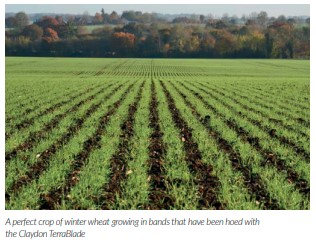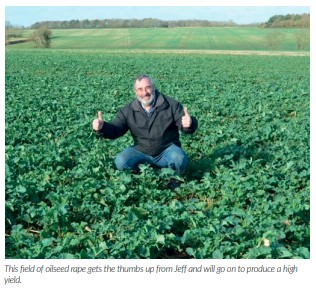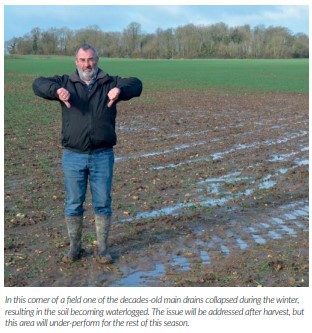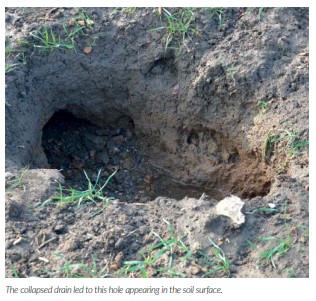
TIME TO CHECK YOUR SOILS TO SEE WHERE IMPROVEMENTS CAN BE MADE.

Spring is the ideal time to take stock of your soils, test how good they are, look for signs of compaction and check that drainage is operating correctly, says Jeff Claydon. In this article the Suffolk farmer and inventor of the Opti-Till® direct strip seeding system shares what he has found on his own land.
26.02.2022
Despite challenging autumn weather, all our crops were established on time, according to plan and without issues. They looked exceptional going into winter and continue to do so but keeping them that way means focusing on the fundamentals and striving to improve every aspect of what we do. The arrival of warmer weather will see crops really begin to really grow away, so now is the ideal time to examine areas where everything is going well and identify those that disappoint. The reasons for inferior crop performance could include drilling in the wrong conditions, slug damage, or as is often the case but frequently overlooked, poor drainage. The tell-tale signs of that include areas which struggle to grow away in spring, poorly-established patches within fields, where water ‘ponds’ or where it has eroded the soil and created small gullies. Good drainage is fundamental to healthy soils and high yields, regardless of the establishment method which is used. To a certain extent, ploughing can mask drainage problems, but for direct drilling to yield its best results this is an area that must be spot on. The Claydon website (claydondrill.com) has videos on soil health and resilience, which make for interesting viewing.
Grants for land drainage ended in the 1970s and many existing schemes are now obsolete or ineffective, which is a major blow to the farming sector and its ability to produce food. Effective drainage helps soils to dry out and improves timeliness, makes them easier to manage, enables fertilisers and ag-chems to work most efficiently and minimises leaching. This can typically result in yield improvements of 25%-30%. New land drainage systems can therefore start to pay for themselves very quickly, but increasingly land is farmed on short term tenancies resulting in a reluctance for either tenants or owners to invest.
It is not difficult to identify areas where drainage is below par. If, after heavy rainfall, water flowing from field drains is dirty this indicates that it is full of sediment, so your most valuable asset is being washed away. Apart from increasing the risks of soil erosion and flooding this sediment will also block worm holes and capillaries, killing worms, starving the crop’s roots of essential air and nutrients, reducing yield potential, and increasing the cost-per-tonne of production.
Identifying areas for improvement
I have been walking the farm this week to see where improvements can be made. Every farm has areas that are less than perfect and ours is no different, but we continually strive to improve the situation. Most of the Claydon farm is drained and less than 10 per cent has issues or needs additional drainage. After two decades of using Opti-Till® our soils are very well structured, allowing water to permeate freely.

This is not to say that everything is perfect, however. We have fields where the drainage schemes went in during the 1960s, so they are well past their sell-by date and in need of replacement. On the 200 acres that we purchased in 2016 there are a couple of areas where old drains have failed, and some surface ponding is evident after heavy rain. There, we will need to install additional laterals and run moles into them, but like many who want to invest in drainage we are in a dilemma.

Defra would do well to reinstate drainage grants as well as funding attenuation ponds to catch sedimentation and control the release/flow of water. Will they see sense? I do hope so. A good friend, Harry Henderson (Knowledge Exchange Manager – Cereals & Oilseeds) at AHDB, says that he would prefer to see grants to the farming industry directed towards drainage rather than the purchase of notill drills, and I fully support his view because well drained land is far less susceptible to erosion or weed infestations and much more productive.
Well drained land acts like a sponge, so water is gently filtered through the soil and released steadily, unlike waterlogged soil which washes off the top. Healthy soil copes better with weather extremes and our high organic scores on the farm have certainly proved their worth.
A straightforward way to deal with areas of poor drainage is to put them into an environmental scheme, which can work well in specific circumstances and be highly beneficial where there is no viable alternative. However, I believe that as a nation we need to remember that the primary aim of farming is to produce food. The current generation, in this country at least, has always been in the fortunate position of not needing to worry about having enough food, because there has always been a plentiful supply.
But it is easy to forget that the combination of an increasing population and political unease around the world could bring serious problems, with little warning. Just this morning as I write this, tensions between Russia and Ukraine have boiled over, resulting in military action, which just goes to show how easily the balance of normal life can change overnight. That can have serious knockon effects, both for those directly affected, by supply shortages and on a global basis through higher prices. In my view there is no excuse for a nation not to prioritise its food supply and taking good agricultural land out of food production makes absolutely no sense.
Crops look good
Our crops are well placed to grow away quickly as warmer weather arrives, when we will also be able to see how well autumn-applied herbicides have performed. Their effectiveness varies from 80% to 40%, so it is impossible to achieve the 98 per cent level required to control grassweeds using agchems alone. Effective stubble management and good rotations are therefore essential to stay on top of grassweeds. Many farms with grassweed issues try to get around them by ploughing, but that merely buries the seeds, which lie dormant and live to fight another day. Similarly, deep cultivations mix weed seeds throughout the soil profile, prolonging the pain of dealing with them.

The best approach is to keep them in a tight layer near to the surface and use a combination of crop rotations, stubble management and chemical/mechanical methods. On the Claydon farm we use Opti-Till® to establish combinable crops and sow in bands 300mm apart, so it is easy to spot any grassweeds growing between the rows. To enhance the control provided by chemicals, we use the Claydon TerraBlade inter-row hoe. Initially, we thought that it would only be deployed in areas with a specific grassweed issue but using it to control even low levels has brought huge benefits. Now, when a cereal crop gets to GS30 and the soil has dried to a level where it could be rolled, we use the TerraBlade to remove any weeds growing between the bands. This approach has been remarkably successful.

To develop and quantify the benefits of this combined approach we have been working with Agrii after early counts showed a 60 per cent reduction in viable blackgrass heads, equally as good as from some chemical controls.
At Agrii’s Stow Longa trials site in Cambridgeshire the company’s Trials Manager Steve Corbett is evaluating different establishment systems. Last year when I visited the trials, Steve emphasised the importance of operating a flexible farming system and resilient method of establishment. He also reminded me that drills are tools, not miracle workers and that the soil must be right to get the best from them. He also highlighted the critical role of soil health in achieving consistent crop performance.
Agrii evaluated a range of approaches, from no cultivations to the full Claydon Opti-Till® programme, including the use of the Claydon Straw Harrow, TerraStar light rotary cultivator and TerraBlade inter-row hoe in the spring to reduce blackgrass levels. The results were illuminating. Even though a full chemical control programme was used across all trials it was very apparent that the lower the level of stubble management, the higher the weed pressures were in the crop. Where no stubble management was done the yield was over 2t/ha less than where the full Claydon Opti-Till® System was used. At current wheat prices, around £220 per tonne that represents potential lost income of over £440/ha.

Agrii’s work also proves that the TerraBlade is exceptionally effective in reducing the number and yieldsapping effect of weeds between the band-sown rows. Where used it produced an additional 1.4t/ha yield advantage (9.02 t/ha v 8.4 t/ha), worth around £310 based on current feed wheat price of £220/t for March 2022, as a result of enhanced grassweed control. That underlines the value of this remarkably effective, low-cost method of supporting existing ag-chem programmes.

With fertiliser prices at extremely elevated levels and the cost of other inputs rising rapidly, it is more important than ever to make the most efficient use of everything that goes into producing crops. Effective drainage is a key element in achieving that, so I hope that you will join Harry and me in lobbying Defra to bring drainage grants forward so that we can all farm in the most environmentally friendly, cost-effective way.